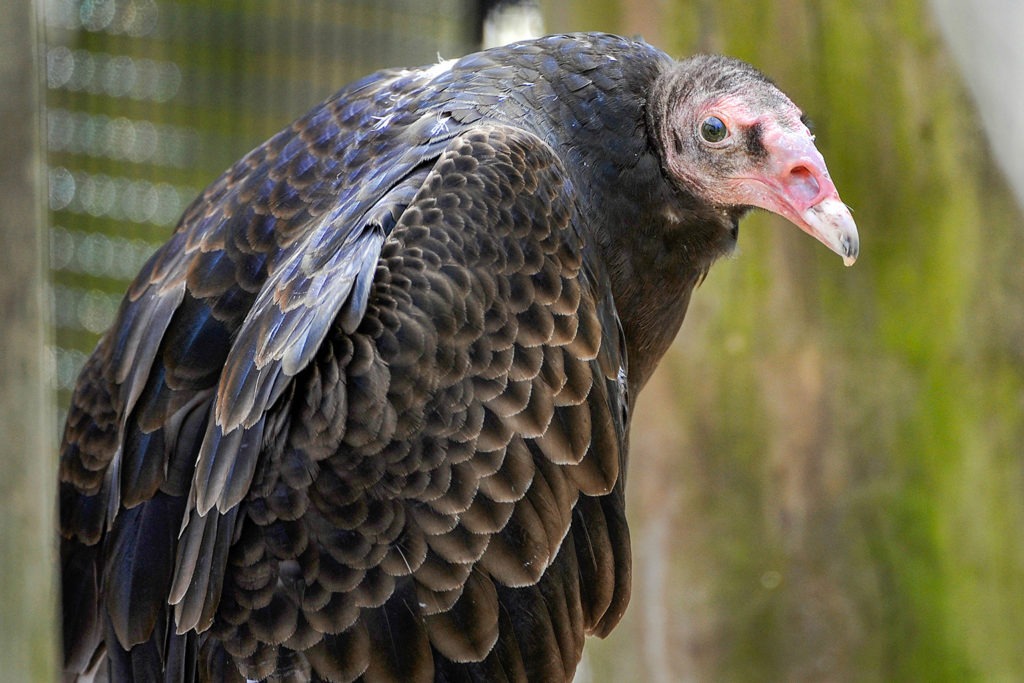Overview
“Where I live”
Turkey vultures are birds of the Americas, ranging from coast to coast and from southern Canada all the way to the southern tip of South America. The species is native to Maryland.
“How I live there”
Turkey vultures are commonly sighted near roadways, open areas such as farms and countryside, and in places where garbage and food are plentiful such as trash heaps, dumps, landfills, and construction sites. At night, they roost in trees or on rock ledges and other high places (including roofs). They often roost in large groups and migrate in even larger groups that may number in the thousands.
First thing in the morning, you may see turkey vultures standing with outstretched wings, presumably warming or drying them in the sun. During the day, they forage for food either on their own or in small groups. They look for carrion and almost never attack live prey. They tend to congregate near dumpsters and roadkill. More than one turkey vulture may gather at a carcass but they take turns feeding, with one chasing others off until it has had its fill. Other species of vulture and raptor may also turn up and, despite their large size, turkey vultures are easily intimidated by competing scavengers.
New World vultures–those from North and South America–are either bald or have very few feathers on their heads. This adaptation allows them to clean themselves more efficiently after scavenging raw meat. All vultures also have strong stomach enzymes and apparently excellent immune systems that allow them to digest rotting meat without contracting botulism or other bacterial illnesses.
“Making my mark”
If you look up in the sky and see a huge bird that you think might be an eagle but you notice that it is making wobbly circles with its broad wings raised in a V, it is most likely a turkey vulture. Soaring low to the ground or up high on heat thermals, turkey vultures use their keen senses of sight and smell to detect fresh carcasses on the ground, even those that are not visible from the air. The part of their brains dedicated to processing smell is known to be exceptionally large compared to other birds.
The word vulture probably comes from the Latin vellere, which means to pluck or to tear. The scientific name for turkey vulture is more pleasantly poetic. Cathartesaura means “golden purifier.” The colloquial term for vulture in the U.S. is “buzzard.”
“What eats me”
Turkey vultures have few natural predators. They can suffer persecution by people who consider them a nuisance or, misguidedly, carriers of disease. (Vultures actually help reduce rather than promote disease.) They can also be poisoned by ingesting meat contaminated by poison or lead shot.
Raising Young
Turkey vultures will feed and roost near humans but prefer to nest in remote, undisturbed areas. They seek out protected rock crevices, caves, hollow logs, fallen trees, or abandoned mammal burrows, nests, or buildings. They do not build nests; rather, females scrape out a slight depression. They lay 1-3 eggs per clutch and incubate the eggs for 28-40 days. After hatching, chicks will stay in the nest for up to 3 months and both parents will care for them. Even after chicks have fledged, family groups will stay together for a few more months. Juveniles are easily recognized by their dark heads and beaks.
Conservation
Turkey vultures are currently listed as a species of “least concern” by the IUCN, the world’s leading conservation organization. Their population declined during the 20th century, due in part to exposure to the fertilizer DDT, but turkey vultures have since made a comeback across their entire range. They are protected by state law in Maryland and by the federal Migratory Bird Act of 1918. It is illegal to take, kill, or possess a turkey vulture in the U.S., and these birds are protected by similar laws in Canada and Mexico.
Taxonomy
- Kingdom: Animalia
- Phylum: Chordata
- Subphylum: Vertebrata
- Class: Aves
- Order: Accipitriformes
- Family: Cathartidae
- Genera: Cathartes
- Species: aura


